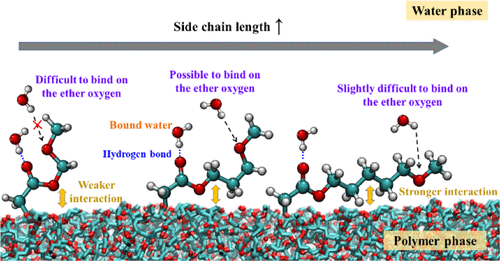当前位置:
X-MOL 学术
›
ACS Biomater. Sci. Eng.
›
论文详情
Our official English website, www.x-mol.net, welcomes your feedback! (Note: you will need to create a separate account there.)
Molecular Dynamics Study on the Water Mobility and Side-Chain Flexibility of Hydrated Poly(ω-methoxyalkyl acrylate)s
ACS Biomaterials Science & Engineering ( IF 5.8 ) Pub Date : 2020-11-29 , DOI: 10.1021/acsbiomaterials.0c01220 An-Tsung Kuo 1 , Shingo Urata 1 , Ryohei Koguchi 2 , Toshiki Sonoda 3 , Shingo Kobayashi 3 , Masaru Tanaka 3
ACS Biomaterials Science & Engineering ( IF 5.8 ) Pub Date : 2020-11-29 , DOI: 10.1021/acsbiomaterials.0c01220 An-Tsung Kuo 1 , Shingo Urata 1 , Ryohei Koguchi 2 , Toshiki Sonoda 3 , Shingo Kobayashi 3 , Masaru Tanaka 3
Affiliation

|
Intermediate water (IW) is known to play an important role in the antifouling property of biocompatible polymers. However, how IW prevents protein adsorption is still unclear. To understand the role of IW in the antifouling mechanism, molecular dynamics simulation was used to investigate the dynamic properties of water and side-chains for hydrated poly(ω-methoxyalkyl acrylate)s (PMCxA, where x indicates the number of methylene carbons) with x = 1–6 and poly(n-butyl acrylate) (PBA) in this study. Since the polymers uptake more water than their equilibrium water content (EWC) at the polymer/water interface, we analyzed the hydrated polymers at a water content higher than that of EWC. It was found that the water molecules interacting with one polymer oxygen atom (BW1), of which most are IW molecules, in PMC2A exhibit the lowest mobility, while those in PBA and PMC1A show a higher mobility. The result was consistent with the expectation that the biocompatible polymer with a long-resident hydration layer possesses good antifouling property. Through the detailed analysis of side-chain binding with three different types of BW1 molecules, we found that the amount of side-chains simultaneously interacting with two BW1 molecules, which exhibit the highest flexibility among the three kinds of side-chains, is the lowest for PMC1A. The high mobility of BW1 is thus suggested as the main factor for the poor protein adsorption resistance of PMC1A even though it possesses enough IW content and relatively flexible side-chains. Contrarily, a maximum amount of side-chains simultaneously interacting with two BW1 molecules was found in the hydrated PMC3A. The moderate side-chain length of PMC3A allows side-chains to simultaneously interact with two BW1 molecules and minimizes the hydrophobic part attractively interacting with a protein at the polymer/water interface. The unique structure of PMC3A may be the reason causing the best protein adsorption resistance among the PMCxAs.
中文翻译:

水合聚(丙烯酸ω-甲氧基烷基酯)的水流动性和侧链柔性的分子动力学研究
众所周知,中间水(IW)在生物相容性聚合物的防污性能中起着重要作用。但是,IW如何防止蛋白质吸附仍不清楚。为了了解IW在防污机理中的作用,使用分子动力学模拟研究了水合的水和聚(ω-甲氧基烷基丙烯酸丙烯酸酯)(PMC x A )的侧链的动力学性质,其中x表示亚甲基碳原子数),其中x = 1–6且poly(n丙烯酸丁酯(PBA)。由于聚合物在聚合物/水界面处吸收的水比其平衡水含量(EWC)多,因此我们分析了水合聚合物的水含量高于EWC的水含量。发现在PMC2A中与一个聚合物氧原子(BW1)相互作用的水分子(其中大多数是IW分子)显示出最低的迁移率,而在PBA和PMC1A中显示出更高的迁移率。结果与预期的一致,即具有长驻水化层的生物相容性聚合物具有良好的防污性能。通过详细分析三种不同类型BW1分子的侧链结合,我们发现与两个BW1分子同时相互作用的侧链数量在三种侧链中表现出最高的灵活性,是PMC1A的最低价。因此,尽管BW1具有足够的IW含量和相对灵活的侧链,但其高迁移率却被认为是PMC1A较差的蛋白质吸附能力的主要因素。相反,在水合的PMC3A中发现了与两个BW1分子同时相互作用的最大数量的侧链。PMC3A的中等侧链长度允许侧链同时与两个BW1分子相互作用,并使疏水性部分与在聚合物/水界面上与蛋白质有吸引力的相互作用最小化。PMC3A的独特结构可能是导致PMC中最佳蛋白质吸附抗性的原因 因此,尽管BW1具有足够的IW含量和相对灵活的侧链,但其高迁移率却被认为是PMC1A较差的蛋白质吸附能力的主要因素。相反,在水合的PMC3A中发现了与两个BW1分子同时相互作用的最大数量的侧链。PMC3A的中等侧链长度允许侧链同时与两个BW1分子相互作用,并使疏水性部分与在聚合物/水界面上与蛋白质有吸引力的相互作用最小化。PMC3A的独特结构可能是导致PMC中最佳蛋白质吸附抗性的原因 因此,尽管BW1具有足够的IW含量和相对灵活的侧链,但其高迁移率却被认为是PMC1A较差的蛋白质吸附能力的主要因素。相反,在水合的PMC3A中发现了与两个BW1分子同时相互作用的最大数量的侧链。PMC3A的中等侧链长度允许侧链同时与两个BW1分子相互作用,并使疏水性部分与在聚合物/水界面上与蛋白质有吸引力的相互作用最小化。PMC3A的独特结构可能是导致PMC中最佳蛋白质吸附抗性的原因 PMC3A的中等侧链长度允许侧链同时与两个BW1分子相互作用,并使疏水性部分与在聚合物/水界面上与蛋白质有吸引力的相互作用最小化。PMC3A的独特结构可能是导致PMC中最佳蛋白质吸附阻力的原因 PMC3A的中等侧链长度允许侧链同时与两个BW1分子相互作用,并使疏水性部分与在聚合物/水界面上与蛋白质有吸引力的相互作用最小化。PMC3A的独特结构可能是导致PMC中最佳蛋白质吸附抗性的原因x As。
更新日期:2020-12-14
中文翻译:

水合聚(丙烯酸ω-甲氧基烷基酯)的水流动性和侧链柔性的分子动力学研究
众所周知,中间水(IW)在生物相容性聚合物的防污性能中起着重要作用。但是,IW如何防止蛋白质吸附仍不清楚。为了了解IW在防污机理中的作用,使用分子动力学模拟研究了水合的水和聚(ω-甲氧基烷基丙烯酸丙烯酸酯)(PMC x A )的侧链的动力学性质,其中x表示亚甲基碳原子数),其中x = 1–6且poly(n丙烯酸丁酯(PBA)。由于聚合物在聚合物/水界面处吸收的水比其平衡水含量(EWC)多,因此我们分析了水合聚合物的水含量高于EWC的水含量。发现在PMC2A中与一个聚合物氧原子(BW1)相互作用的水分子(其中大多数是IW分子)显示出最低的迁移率,而在PBA和PMC1A中显示出更高的迁移率。结果与预期的一致,即具有长驻水化层的生物相容性聚合物具有良好的防污性能。通过详细分析三种不同类型BW1分子的侧链结合,我们发现与两个BW1分子同时相互作用的侧链数量在三种侧链中表现出最高的灵活性,是PMC1A的最低价。因此,尽管BW1具有足够的IW含量和相对灵活的侧链,但其高迁移率却被认为是PMC1A较差的蛋白质吸附能力的主要因素。相反,在水合的PMC3A中发现了与两个BW1分子同时相互作用的最大数量的侧链。PMC3A的中等侧链长度允许侧链同时与两个BW1分子相互作用,并使疏水性部分与在聚合物/水界面上与蛋白质有吸引力的相互作用最小化。PMC3A的独特结构可能是导致PMC中最佳蛋白质吸附抗性的原因 因此,尽管BW1具有足够的IW含量和相对灵活的侧链,但其高迁移率却被认为是PMC1A较差的蛋白质吸附能力的主要因素。相反,在水合的PMC3A中发现了与两个BW1分子同时相互作用的最大数量的侧链。PMC3A的中等侧链长度允许侧链同时与两个BW1分子相互作用,并使疏水性部分与在聚合物/水界面上与蛋白质有吸引力的相互作用最小化。PMC3A的独特结构可能是导致PMC中最佳蛋白质吸附抗性的原因 因此,尽管BW1具有足够的IW含量和相对灵活的侧链,但其高迁移率却被认为是PMC1A较差的蛋白质吸附能力的主要因素。相反,在水合的PMC3A中发现了与两个BW1分子同时相互作用的最大数量的侧链。PMC3A的中等侧链长度允许侧链同时与两个BW1分子相互作用,并使疏水性部分与在聚合物/水界面上与蛋白质有吸引力的相互作用最小化。PMC3A的独特结构可能是导致PMC中最佳蛋白质吸附抗性的原因 PMC3A的中等侧链长度允许侧链同时与两个BW1分子相互作用,并使疏水性部分与在聚合物/水界面上与蛋白质有吸引力的相互作用最小化。PMC3A的独特结构可能是导致PMC中最佳蛋白质吸附阻力的原因 PMC3A的中等侧链长度允许侧链同时与两个BW1分子相互作用,并使疏水性部分与在聚合物/水界面上与蛋白质有吸引力的相互作用最小化。PMC3A的独特结构可能是导致PMC中最佳蛋白质吸附抗性的原因x As。


























 京公网安备 11010802027423号
京公网安备 11010802027423号